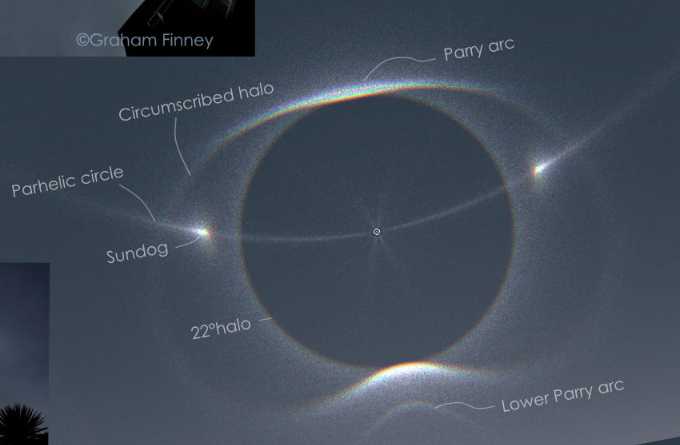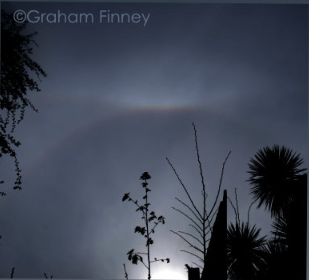Halos & Geometry
Halos & Geometry: A Mesmerizing Display in the Sky
When it comes to atmospheric optics, few phenomena are as captivating as halos. These ethereal displays of light create intricate and precise geometrical patterns on the canvas of the sky. While clouds may appear ever-changing and prone to pareidolia, halos remain almost immutable in their sizes and shapes. However, it is important to note that the sun's height does cause slight alterations in their appearance.
The constancy of halos can be attributed to the strong electric forces between atoms, which compel the ice crystals to form fixed three-dimensional arrays. These arrays ensure that the angles between the faces of ice crystals remain consistent in our macro world. But it is not just the rigidity of ice crystals that plays a role in creating these mesmerizing optical phenomena.
The air surrounding the ice crystals also contributes to their formation. The drag exerted by the air gently pulls the crystals into near-perfect orientations, whether they are long and thin or plate-like. This alignment sets the stage for an enchanting dance of light as the sun's parallel rays reflect and refract through high ice clouds, producing a stunning array of halos.
One of the most impressive halo formations is known as the parhelic circle. This immense and complete circle appears centered almost overhead and extends around the entire sky. It even crosses the sun, maintaining a consistent height above the horizon regardless of its position. The parhelic circle is a testament to the precise geometry at play in atmospheric optics.
As the sun rises or sinks, two halos that change shape come into view. The 22° halo, which touches the parhelic circle, is accompanied by an upper tangent arc that undergoes a transformation as the sun's angle changes. At higher sun positions, this upper tangent arc encircles the sun as a circumscribed halo. Above these halos lies the Parry arc, which may appear well separated from the upper tangent arc or closer to it, depending on the position of the sun.
The intricate geometry of halos is truly a marvel to behold. These optical phenomena serve as a reminder of the complex interplay between light, ice crystals, and atmospheric conditions. They provide a glimpse into the fascinating world of atmospheric optics and the beauty that can be found in the natural world.
In conclusion, halos and their geometry create an awe-inspiring spectacle in the sky. The constancy of their sizes and shapes can be attributed to the forces between atoms that arrange ice crystals into fixed three-dimensional arrays. The drag exerted by the air further aligns these crystals, allowing the sun's rays to reflect and refract through high ice clouds, giving rise to a mesmerizing display of halos. The parhelic circle, upper tangent arc, and Parry arc are just a few examples of the intricate formations that can be observed. These optical phenomena serve as a reminder of the beauty and complexity present in our atmosphere. So next time you gaze at the sky and spot a halo, take a moment to appreciate the captivating geometry that lies within.

Ice halos scribe precise and intricate geometry on the sky. Sighted by Graham Finney in Northern Ireland. The display lasted most of the day.
Ever varying clouds easily induces pareidolia. Not so with halos, their sizes, their shapes are almost immutable. Almost, because the sun's height alone causes them to alter.
Their constancy has roots in the strong electric forces between atoms that force those in ice into fixed 3D arrays. The arrays ensure that in our macro world the angles between ice crystal faces are always exactly the same. Something softer and insubstantial then plays its role. Air's drag tugs the crystals, whether long and thin or plate-like, into near perfect orientations. The stage is set - Sun's parallel rays then have only fixed choices as they reflect and refract through high ice clouds.

Centred almost overhead, this composite image shows an immense and complete parhelic circle around the sky. It crosses the sun and is everywhere the same height above the horizon.


Left: Two halos that change shape as the sun rises or sinks.
Touching the 22° halo is an upper tangent arc that alters its form and eventually at higher sun encircles the sun as a circumscribed halo.
Above that is a Parry arc. Here it is well separated from the upper tangent but in Graham's earlier image at higher sun the Parry arc is much closer.
Note: this article has been automatically converted from the old site and may not appear as intended. You can find the original article here.
Reference Atmospheric Optics
If you use any of the definitions, information, or data presented on Atmospheric Optics, please copy the link or reference below to properly credit us as the reference source. Thank you!
-
<a href="https://atoptics.co.uk/blog/halos-geometry/">Halos & Geometry </a>
-
"Halos & Geometry ". Atmospheric Optics. Accessed on November 16, 2024. https://atoptics.co.uk/blog/halos-geometry/.
-
"Halos & Geometry ". Atmospheric Optics, https://atoptics.co.uk/blog/halos-geometry/. Accessed 16 November, 2024
-
Halos & Geometry . Atmospheric Optics. Retrieved from https://atoptics.co.uk/blog/halos-geometry/.